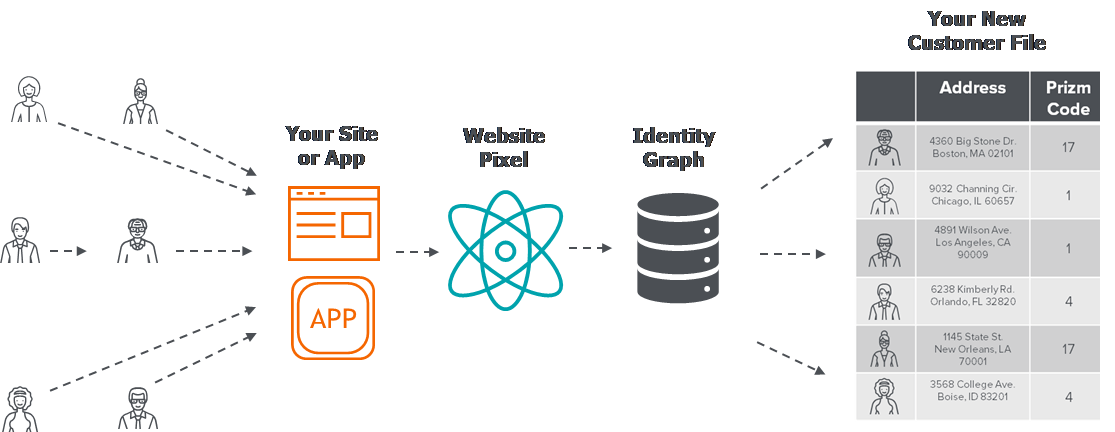
Are You Ignoring Your Most Profitable Customers?
How do I engage the audiences that have the potential to be my best customers? It’s a question that marketers wrestle with daily, and one that most likely keeps some up at night.
The simple answer is to make sure you’re engaging with the audiences who are already engaging with you. They come in many forms, but the vast majority include:
- They’ve surfed your website – but are part of the 90 percent of website visitors who remain anonymous.
- They’ve visited or even purchased something in your retail store – but haven’t registered in your CRM.
- They’ve been paying customers in the past – but you’ve lost track of them.
These consumers have already shown interest in what you’re selling. And they may even be buying from you now. While you probably know these audiences exist, what may surprise you is that these “anonymous” customer groups actually account for 40 percent to 80 percent of a typical company’s consumer revenue.
Imagine how much your company could boost its revenue… if only you knew more about who these customers are and their purchasing preferences. In fact, engaging these prospects may actually be one of the easiest and most efficient ways to drive sales.
That’s because 91 percent of consumers are more likely to shop with you if you recognize them and provide them with targeted, relevant offers and recommendations, according to research from Accenture*.
There’s a strong possibility that you’re not engaging with these audiences at any level now, and even if you are, you may not be customizing your marketing messages enough to get them to convert or raise their hands and say, “please tell me more”.
How to Tap Into Your Anonymous Customer Base
The good news is that you can find out who these anonymous customers are – in a completely privacy-compliant manner. How? Using a proven, four-step process of identifying, segmenting and marketing to anonymous prospects.
The first step in this process is gaining a better understanding of those who are engaging with you without your knowledge – and what exactly that engagement looks like. Statistics show that no matter what your business is, you’re likely losing a whole lot of potential sales every day. Recent estimates show:
- 74 percent of online retail orders are abandoned before purchase, according to Statista**.
- 46 percent of customers “showroom” – or visit a store to check out a product – but then leave with the intent to purchase that product online, according to Shopify***.
But do these customers ever end up buying? And where? You don’t know, because these customers remain anonymous to you.
Capturing these sales is not only possible, it’s easily achievable. But it starts with identifying and connecting more insights into these customers.
Step One: Find Out Who is Engaging with You – and How They’re Doing it
The first step is figuring out who is actually engaging with you but remaining anonymous.
If the customer is surfing your website, simple tags can be used to identify them. When a consumer visits a website, they leave behind a digital trail that includes an anonymous identifier. By placing a pixel on your website, you can capture that information.
If a customer has visited your retail store and paid with a credit card, you probably have point of sale and buying data on that customer – which you can then add to your CRM.
And if they are a former customer you’ve lost touch with, you at least know their name and likely have data on what they previously purchased.
Step Two: Determine What Type of Consumer These Anonymous Customers Are
While you may have some data on these anonymous customers, the information you do have is likely incomplete – and may not be current.
For example, the website tags might give you the visitor’s IP identifier and his or her surfing habits, but no information on that surfer’s actual likelihood to buy. The point-of-sale data might give you an individual’s name, but no good way to contact that person. And your CRM database may contain an email address that the customer abandoned six years ago.
That’s why finding out who is engaging with you – or has in the past – is just the first step. Because to create an effective marketing campaign for these anonymous customers, you need data that removes the “anonymous” label and turns them into known audiences.
That’s where using the right identity graph comes in. You can combine the information you’re collecting or already have from website tags, point of sale data and your existing CRM to create a more complete profile of the anonymous customer who’s engaging with you.

The identity graph can help you fill in more information about that potential buyer, including household information and demographic data, along with information on the ideal channels you should use to reach him or her – for instance, via email, social media or direct mail or by mobile or desktop.
Using that information, you can offer that customer personalized incentives to come back and buy, using a variety of both online and offline communications.
But before you start your marketing efforts, you need to complete step three…
Step Three: Match The Characteristics of the Formerly Anonymous Customers to Those Exhibited by Your Best Customers
Before you retarget these formerly anonymous customers, you need to figure out something very critical – whether they are in fact likely to buy.
You can do that through segmentation and scoring, which allows you to use common attributes to identify “lookalike” customers that have the same or similar characteristics of your best customers.
Using both segmentation and identity graph data, you can compare the demographic data and buying behavior of the formerly anonymous customers with the demographic data and buying behavior of your existing customers – to figure out which anonymous customers are the most likely to buy.
Delving deeper into demographics also helps you weed out those who may be engaged in your site but aren’t good prospects. For instance, say your website pixels identify Land Rover Jimmy (that’s what we’ll call him anyway), an anonymous customer who spends hours on the Land Rover site building his perfect model car. He’s showing a whole bunch of engagement and intent. So he’s the perfect potential buyer, right?
Wrong.
In reality, Jimmy is 18, and until he graduates from college, his best source of income is still mowing lawns in the summer. So the likelihood is that he’s not going to have enough cash to buy a Land Rover for several years yet.
Contrast that with Land Rover Sarah (another fictitious person), who has visited the site and researched a whole lot of safety features. She’s 40 years old, has two kids who attend private school and takes the family camping on the weekends. She’s an attorney who has a household income of over $300,000.
With those demographics, it’s not surprising that the data shows that Sarah is a much more likely buyer than Jimmy.
Combining identity graph data with segmentation data allows you to understand what your best customer looks like – thus allowing you to focus your marketing efforts on those who are most likely to convert.
So now you’ve used tags, point-of-sale data and even your existing CRM to identify the anonymous customers who not only look like your best customers but have also engaged with your brand already. These are the audiences who are looking for a reason to purchase from you, and with the ability to engage with them based on their lifestyle and interests, you’ve positioned yourself to give that to them.
What’s the final step?
Step Four: Contact Those Potential Customers and SELL!
It’s time to engage, whether that be through email, social media, display ads or direct mail – or a combination of all of the above. Because data alone is just a commodity. Everyone has it. It only becomes valuable when you can actually use that data to drive sales.
Through the right identity graph linkage, you should now have insight into the media channels your target audience prefers – for instance, are they heavy email users or Facebook fans – so that you can target them accordingly.
One campaign conducted by a mid-size advertising agency, Claritas helped the agency capture data on its website traffic. Then Claritas helped the agency determine which visitors were the agency’s best potential buyers using geographic and job title/function data.
After that, the data was analyzed further to determine the appropriate channel mix to use to target these audiences – and found that the best mix was a combination of email, LinkedIn and direct phone calls****.
In another campaign for Nutrisystem, the company worked with Claritas to identify its anonymous website customers and segment them according to a variety of characteristics, including website engagement and actual spending habits.
Nutrisystem then retargeted those specific segments with an email marketing campaign. The results were amazing, as Nutrisystem was able to reduce its cost-per-acquisition by 42 percent.
Just think of how much revenue – and cost-savings – you could generate with a similar campaign targeting potential buyers that have already shown interest in your brand.
That’s the power of engaging with your anonymous customers. Contact us today and let us help you identify and engage with the audiences who have already shown they’re interested in you.
*https://newsroom.accenture.com/news/widening-gap-between-consumer-expectations-and-reality-in-personalization-signals-warning-for-brands-accenture-interactive-research-finds.htm
**https://www.statista.com/statistics/457078/category-cart-abandonment-rate-worldwide/
***https://www.shopify.com/retail/119920451-consumers-are-showrooming-and-webrooming-your-business-heres-what-that-means-and-what-you-can-do-about-it
****https://acquireweb.com/ad-agencies-converting-anonymous-business-visitors-to-known-prospects/

